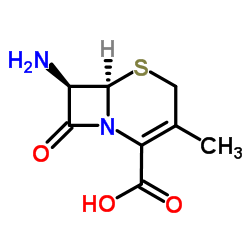Environmentally safe production of 7-aminodeacetoxycephalosporanic acid (7-ADCA) using recombinant strains of Acremonium chrysogenum.
J Velasco, J Luis Adrio, M Angel Moreno, B Díez, G Soler, J L Barredo
Index: Nat. Biotechnol. 18(8) , 857-61, (2000)
Full Text: HTML
Abstract
Medically useful semisynthetic cephalosporins are made from 7-aminodeacetoxycephalosporanic acid (7-ADCA) or 7-aminocephalosporanic acid (7-ACA). Here we describe a new industrially amenable bioprocess for the production of the important intermediate 7-ADCA that can replace the expensive and environmentally unfriendly chemical method classically used. The method is based on the disruption and one-step replacement of the cefEF gene, encoding the bifunctional expandase/hydroxylase activity, of an actual industrial cephalosporin C production strain of Acremonium chrysogenum. Subsequent cloning and expression of the cefE gene from Streptomyces clavuligerus in A. chrysogenum yield recombinant strains producing high titers of deacetoxycephalosporin C (DAOC). Production level of DAOC is nearly equivalent (75-80%) to the total beta-lactams biosynthesized by the parental overproducing strain. DAOC deacylation is carried out by two final enzymatic bioconversions catalyzed by D-amino acid oxidase (DAO) and glutaryl acylase (GLA) yielding 7-ADCA. In contrast to the data reported for recombinant strains of Penicillium chrysogenum expressing ring expansion activity, no detectable contamination with other cephalosporin intermediates occurred.
Related Compounds
| Structure | Name/CAS No. | Molecular Formula | Articles |
|---|---|---|---|
 |
7-Aminodeacetoxycephalosporanic acid
CAS:22252-43-3 |
C8H10N2O3S |
|
Enhanced enzymatic synthesis of a semi-synthetic cephalospri...
2003-07-01 [Biotechnol. Lett. 25(14) , 1195-8, (2003)] |
|
Enzymatic production of cephalexin.
1994-08-01 [Enzyme Microb. Technol. 16(8) , 715-8, (1994)] |
|
Continuous cultivations of a Penicillium chrysogenum strain ...
2003-08-05 [Biotechnol. Bioeng. 83(3) , 353-60, (2003)] |
|
Continuous cultivations of a Penicillium chrysogenum strain ...
2003-08-05 [Biotechnol. Bioeng. 83(3) , 361-8, (2003)] |
|
Process design for enzymatic adipyl-7-ADCA hydrolysis.
2002-01-01 [Biotechnol. Prog. 18(4) , 745-51, (2002)] |